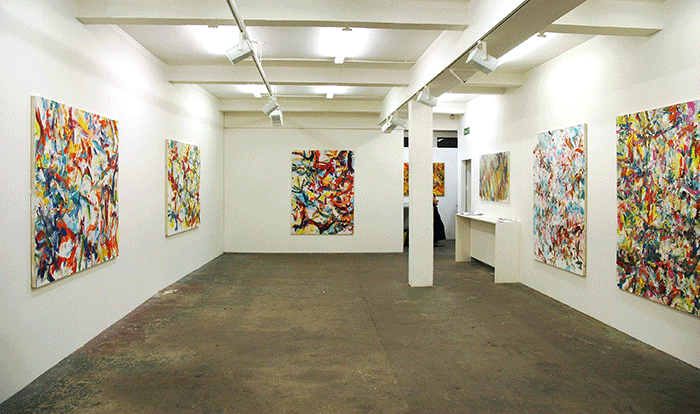
|
Home Welcome Paintings Works on Paper Studio Solo Exhibitions Biography Contact News Credits Links Privacy Policy |
David Lendrum’s Paintings
by Patrick Jones, 1st March 2006
[The text was written as an introduction for the catalogue of the Exhibition at the Poussin Gallery, London, 15th June - 1st July 2006]

David Lendrum is an unusual man. I have known him for thirty years and what
remains extraordinary is his love of art. This is everywhere in evidence in
his home, in his personal collection and his library. His taste is impeccable
and particular. His heroes are the painterly, colourful Hans Hofmann and Paul
Cézanne.
It is fair to say his life is lived for art. I know myself that this love can
be a double bind. History informs, inspires but also presents challenges and
expectations of success in artistic terms that can seem an unsurmountable
barrier. This can become a burden to personal achievement in the here and now.
I was delighted to find upon visiting David Lendrum’s studio that his work is
at a very exciting stage in his development. Like all good artists he is open
to influence and he may now be looking at work slightly outside his pantheon,
toward late Willem de Kooning and Patrick Heron’s White Paintings.
To explain his procedure is to say that he works on medium size stretched and
primed canvases of a squarish rectangle. These he “attacks” with a variety of
loaded brushes. “Attacks” is relevant because the marks are charged with
energy and velocity, and seem to skim across the surface.
Rather than the existential gravitas of Abstract Expressionism there is a
feeling of depth and surface akin to Monet’s Waterlilies, which Lendrum has
dealt with in earlier canvases. One would think that such an adventurous
process would guarantee excitement, but not so as anyone who has tried it will
know. Our innate need for balance and order causes the eye and brain to search
for connections between rhythms and clusters of marks and colours, whether or
not they are intended. This rationality and ordering is exactly what Lendrum
has to overcome.
In his best works the marks skitter across the surface suggesting a space much
larger than the container of the canvas shape. Lendrum starts with larger dry
and dragged cooler hues, the space advances in colour waves and it seems to me
this is his area of strength. His colour choices and avoidance of tonal
clustering gives the paintings an enormous sense of vitality. I am sure this
is what he is after – excitement, velocity and emotional resonance. He has
stated to me that he wishes the structure to be inherent in the marks. He
wants the colours (complementaries) to reflect light across the surface. All
this he achieves.
There is an argument that Abstract Painting needs a long apprenticeship.
Lendrum has been unusually thorough in his studying. That he is now, in his
late fifties, throwing caution to the wind, mirrors his hero Hofmann, whose
work blossomed when he closed his school. Lendrum’s achievement, which is
clearly apparent in his new work, is down to his nerve, flair and
dispossession of a doctrinaire approach.
The emotional resonance and sense of celebration he seeks depends on actions
and judgements made in the privacy of his studio. The way in which they are
interpreted is down to the ability of the individual viewer to look at the
paintings with sustained attention, an open mind and a clear unjaundiced eye.
Every smudge, drip and scattering of lacunae, actually brings him closer to
something essential which exists in Jackson Pollock’s mature works. Pollock
stated that “I am nature” and it strikes me that Lendrum is moving away from
Monet and the way painting reproduced nature, to a more inward assessment.
Lendrum’s studio is located in one of those industrial buildings reminiscent
of the Eastern bloc. There is no room for diversification when you get there,
just a large white cube with metal windows. The only view is the tangle of
vegetation that provides wildlife refuge in the Metropolis. Lendrum referred
to this as a stimulus for colour. The locality is harsh, scaffolding yards,
garages and industrial waste. The glamour of the art-world seems miles away
with its back turned.
Lendrum certainly possesses the stoicism to weather changes in fashion, and
yet one senses an erupting warmth, generosity and real wish to communicate,
and share his pleasure. He is daily in a process of throwing away crutches –
being careful as he has said “not to throw the baby out with the bathwater”.
I am fascinated to see where Lendrum’s work moves next, for he is an artist
going places and I am sure there is more experimentation and resolution to
come.